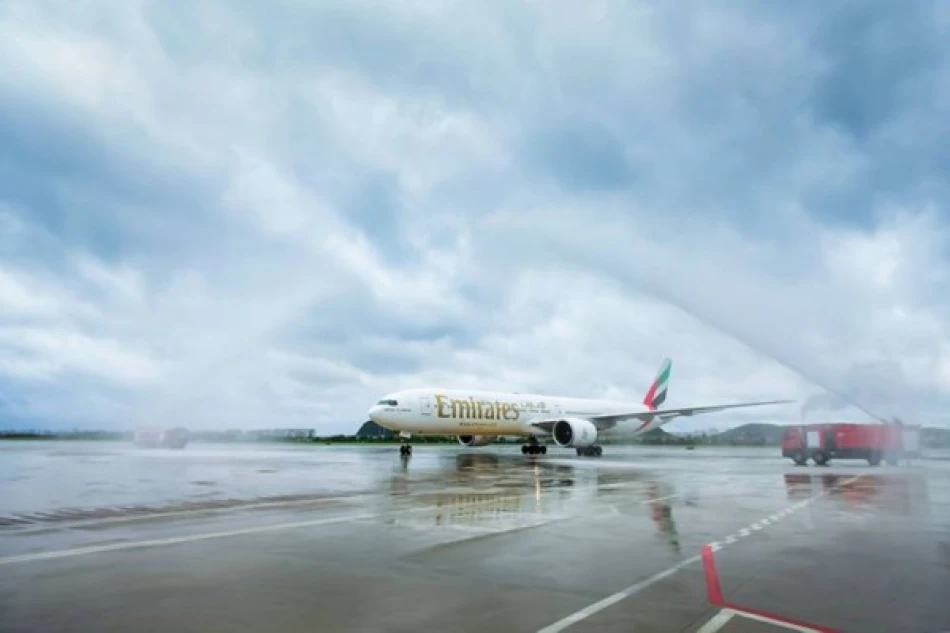
Emirates Launches Daily Flights to Hangzhou, China's Vibrant Tech and Tourism Hub
Emirates Doubles Down on China with Hangzhou Launch, Signaling Major Asian Aviation Recovery
Emirates has officially launched daily flights to Hangzhou, marking its fifth gateway to mainland China and second new Chinese destination in less than a month. The aggressive expansion signals both the airline's confidence in post-pandemic recovery and China's growing importance as a global aviation powerhouse, particularly for cargo and e-commerce logistics.
Strategic Timing Reflects Market Confidence
The inaugural flight EK310 touched down at Hangzhou Xiaoshan International Airport amid traditional water cannon celebrations, carrying passengers from across Emirates' global network including the UAE, Nigeria, Italy, Spain, Saudi Arabia, and Brazil. This diverse passenger manifest demonstrates the pent-up demand for China connectivity that has been building since the country's borders reopened.
Adding two Chinese destinations within a month represents an unusually rapid expansion pace for Emirates, suggesting the Dubai-based carrier sees a narrow window of opportunity to capture market share before competitors fully return to pre-pandemic capacity levels.
The E-commerce Cargo Play
Beyond passenger traffic, Emirates is positioning itself to capitalize on China's e-commerce boom. Each Boeing 777-300ER flight offers 16 tons of cargo capacity, specifically targeting time-sensitive shipments including pharmaceuticals, electronics, and high-value goods.
Hangzhou's status as one of the world's largest cross-border e-commerce hubs makes this route particularly strategic. Home to Alibaba's headquarters, the city has developed sophisticated digital infrastructure and logistics networks that have made it a gateway for Chinese brands expanding globally.
Competitive Advantage Through Dubai Hub
Emirates' Dubai hub provides a crucial advantage in connecting Chinese exports to emerging markets in the Middle East, Africa, South Asia, and Latin America—regions where European and American carriers have limited presence. This positions Emirates as a bridge between China's manufacturing powerhouse and the world's fastest-growing consumer markets.
Broader Asian Aviation Recovery
The Hangzhou launch reflects broader trends in Asian aviation recovery. While European and American routes have largely returned to pre-pandemic levels, Asia-Pacific remains the final frontier for international travel normalization. Emirates' aggressive China expansion mirrors similar moves by Singapore Airlines and Cathay Pacific, all racing to rebuild Asian networks.
Adnan Kazim, Emirates' Chief Commercial Officer, emphasized that China has become "one of the world's largest aviation markets," with the airline now operating 49 weekly flights across five Chinese cities: Beijing, Shanghai, Guangzhou, Shenzhen, and Hangzhou.
Market Implications
For investors and industry watchers, Emirates' China expansion signals several key trends. First, Gulf carriers are increasingly confident about Asian market recovery after three years of uncertainty. Second, the focus on cargo-heavy routes suggests airlines are hedging against passenger volatility by prioritizing freight revenue.
The timing also reflects geopolitical realities. As Western airlines face pressure over various China-related issues, Middle Eastern carriers like Emirates, Qatar Airways, and Etihad are positioning themselves as neutral bridges between East and West.
With convenient connection times through Dubai, the new Hangzhou service connects passengers to 40 European destinations, 21 African cities, and 13 Middle Eastern locations, plus routes to Brazil and Argentina. This extensive connectivity could prove decisive as business travel between China and emerging markets continues recovering throughout 2024.
Most Viewed News

 Layla Al Mansoori
Layla Al Mansoori






